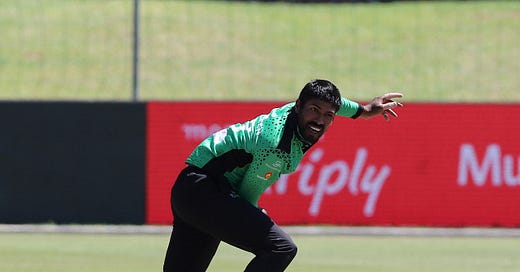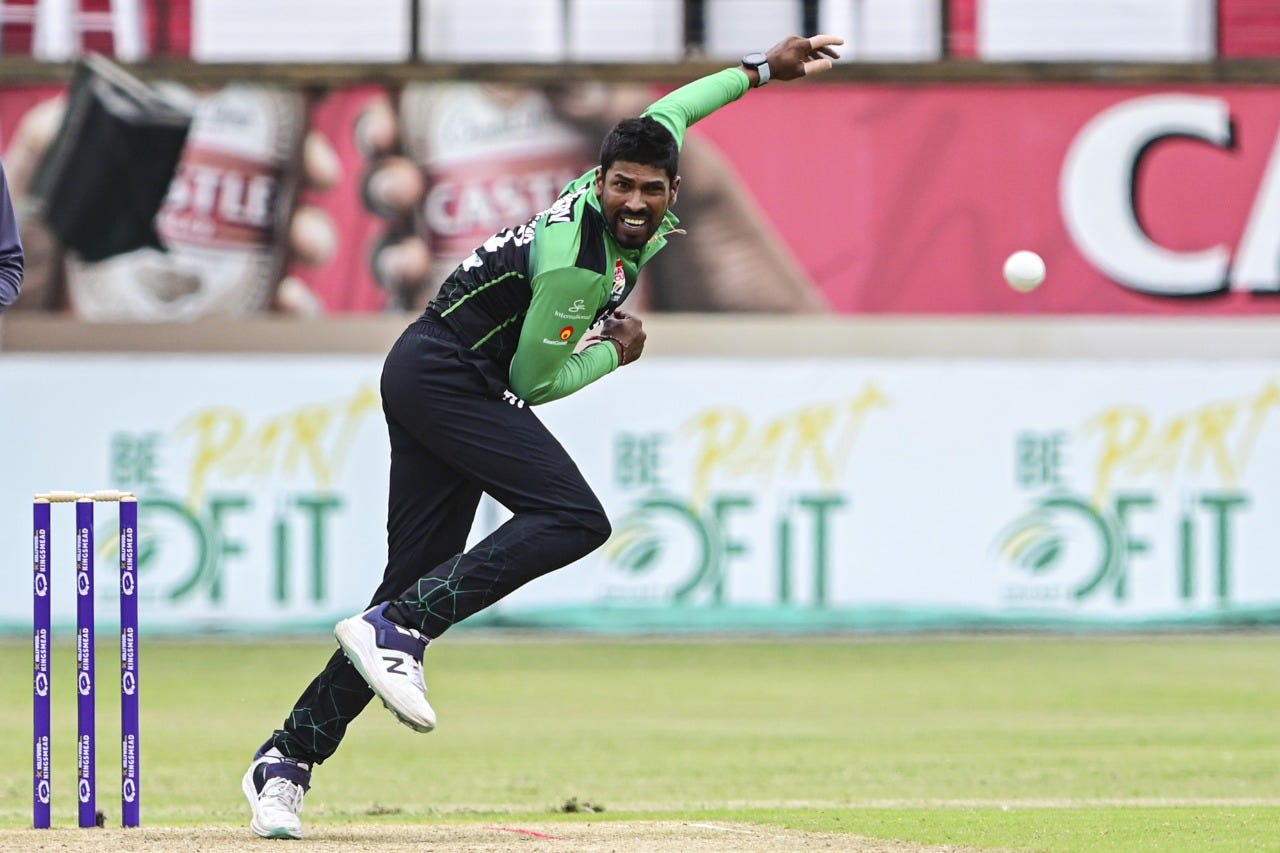UNCAPPED PICKS: Prenelan Subrayen
The “Uncapped Picks” series continues with a new piece, an essay on Prenelan Subrayen. “Uncapped Picks”, as the name suggests, features the six uncapped players picked by SA20 franchises before the auction. These pieces are designed to bring these incredible players closer to you, the fans. Draw the curtain and allow you to look into their world. We’ll have a new “Uncapped Picks” essay over the next few weeks. It should be really fun. Thanks, as always, for your support!
No. 1 Ottniel Baartman
No. 2 Dewald Brevis
No. 3 Gerald Coetzee
No. 4 Migael Pretorius
Hello, welcome to Stumped! If you are not yet a subscriber, join more than a thousand other professional athletes & ex-pros, coaches, commentators & analysts and casual sports fans that receive the newsletter in their inbox each week — it’s free:
The window had a hole the size of a cricket ball, and the shards on the floor told the rest of the story. Prenelan Subrayen had been the slowest off the mark and got caught before he took three steps to flee from the scene. All Prenelan could manage was a meek apology.
It was not the first window Prenelan and his mates had broken. This was the first time Prenelan had been caught for the offence. The boys had a ‘break and dash’ policy. The youngsters’ break and dash reminded Kugan, Prenelan’s father, of his youth. Kugan and his brothers and cousins did the same thing. Their ‘break and dash’ was even more fun because they had an adult in the circus.
“One of my uncles, Mr Vadi Subrayen, taught us about the games, and he played with us in the backyard. When we broke windows, we just ran like hell. And my uncle, although he was so big, and he was teaching, he also ran with us. So, I suppose those things can stick in your mind and when your own son is doing this thing, you tend to pardon these things,” says Kugan Subrayen.
Prenelan Subrayen had been doing his best Klusener re-enactment when he broke the window. He had employed a slog sweep against medium-pace bowling.
There was a time when five out of 11 South African youngsters wanted to play cricket like Lance Klusener. In KZN, Zulu's kingdom, the numbers were higher, two out of three kids wanted to be the next Lance Klusener.
Klusener considered himself a ‘fill-in bowler who could bat a bit.’ A bits and pieces player. An apt description for a man who had his first proper net session at 20. But, millions of South African youngsters saw him in a different light. To them, Klusener was counter-culture, a revolutionary. He attacked balls that lower-order batters of his time defended or took singles from. There is nothing more telling than his T20 strike rate of 136.10. Klusener last played cricket in 2010.
Klusener relentlessly attacked bowlers. He played high-octane cricket.
“I remember my mom and dad used to take us to the Kingsmead to watch the Dolphins play. We used to sit in the eastern end for the night games, and I clearly remember seeing Klusener hit some massive sixes over the west end. I grew up with dreams of hitting the ball like that,” says Subrayen.
The hills on one side of the club give the cricket ground a sense of being nestled in a valley. A stadium effect. With that backdrop, this was Subrayen's Kingsmead, Verulam Cricket Club.
Verulam CC was Prenelan Subrayen’s starting point. He was a legacy member of Verulam CC. His grandfather was a member. His father was a member. His uncles were members and Kugan, Prenelan’s father is part of the furniture. Besides playing for the club, Kugan Subrayen, who holds a level-three coaching qualification, has run and coached at the Verulam Development Center for fourteen years. The development centre is found at Verulam Cricket Club.
The club is only a minute away from the Subrayen home. The windows of the Subrayen home were in as much danger from the big hitters playing at Verulam CC as they were from Prenelan and his friends playing in street or backyard cricket.
Prenelan was barely 18 months old when he took his first steps there. He did so with a bat in hand. A yellow plastic bat that he dragged everywhere he went from the moment he could walk. The sound of hard plastic scratching the floor or bobbing up and down the pavement, alerted everyone to Subrayen’s presence.
It’s here where he re-enacted Klusener's deeds when he was not trying it out in the backyard. He did it on Saturdays on the embankment when the adults were playing in the middle and he did it on the pitch when the adults were not playing. It was also here that his father taught him how to play the game.
“I think we had the first structured session for him at maybe six where we started doing throw downs for him. That’s when I started teaching him the basics of batting,” says Kugan. “He's got beautiful hands, if I may say so myself, and in terms of batting, he is able to time the ball very easily. He hits a long ball. I think he can hit it in areas where other guys can hit it because he's such a natural timer of the ball.”
Throughout his school career and at the Under-19 level, Prenelan scored fantastic centuries. He batted in the top six. Like his father, at one point in his career, Prenelan Subrayen was a batting allrounder. His batting slipped away when he made the step up to professional cricket. He had to choose a trade and he chose bowling and gradually paid less attention to his batting.
“It never really goes away. I can still bat, but just not top six level of batting,” says Prenelan.
This Substack column exists thanks to patrons and readers that leave tips. Stumped! is wholly supported by Readers Like You. To keep the weekly posts coming and to keep the lights on here, consider leaving a tip or supporting monthly on Patreon. You won’t regret it!
The first delivery of the over, and the bails were flying. The off stump stood at an acute angle - almost falling over - and the middle stump was slightly out of position. The batter did not know what had happened. Kugan Subrayen has seen stumps tumble a number of times in his life, both as a cricket fan and as a coach, but this was one of the best first-ball dismissals he had ever seen.
The delivery that disrupted the furniture, the one that was one of the first-ball dismissals Kugan Subrayen had ever seen, was bowled by Prenelan Subrayen. It made one think of Klusener. Prenelan bowled it in his first competitive hardball cricket match. Prenelan Subrayen had all the makings of a pace bowler and his father, a lifelong coach, could have overseen the development of a better and improved Lance Klusener because Prenelan could bat too.
But Kugan Subrayen had concerns. South Africa produces pace bowlers on demand and he was afraid that Prenelan might limit his options if he focused on becoming a pace bowler. On the other hand, there were fewer quality spinners around.
“I actually became a spinner because when I was probably eight or nine years old, my dad and I had a conversation where he said that at that stage, there were a lot of fast bowlers in the country and he said that maybe it's an option for me to bowl spin and get really good at it and concentrate on that from a young age,” says Subrayen.
From the moment he agreed to make the switch, Subrayen probably spent more time working on his bowling than any other kid at his school. He did his best Muttiah Muralitharan impression whenever he got an opportunity. At any time of the day, people knew that when he was not attending his lessons, he would be in the nets. When other kids were ‘studying in the library, Subrayen doing target bowling’ with cones.
When sportswriter Daniel Coyle visited talent hotbeds, he expected to see otherworldly movement and execution. He expected to be dazzled. And he was right. He was met with grace, speed and impressive power. Everything the youngsters at a hotbed did just looked more fluent. “You haven’t had your ego truly tested until an eight-year-old takes pity on you on the tennis court,” he wrote.
But, that only happened half of the time. During the other half of the time, he saw them struggle and look unsure. Their progress was a matter of small failures. In Sao Paolo, Coyle saw a youngster trying to learn the elastico, a football skill. The young man stood still and moved his foot over the ball slowly as if he was trying to the feel ball roll beneath his foot.
Watching Prenelan Subrayen’s training reminds me of these scenes. In one part of his training, Subrayen is efficient and free-flowing. He methodically knocks out strategically placed cones. He goes from four cones to none in the blink of an eye. At one time in his career, Subrayen used to replace the last cone with a five-rand coin and tried to land the ball on it repeatedly.
“I remember going into a SA under 19 and Ray Jennings was the coach at the time. He spoke about afterwards hitting a five-rand coin, and that that stuck in my head,” says Subrayen.
The other half of his practice is full of fitful movements. After a delivery, he stares at where the ball landed, makes a mental note and goes back to his mark to start again. The ball doesn’t look like it’s doing what he wants, and neither is it landing where he wants. At one point he halts his run-up before he releases the ball and walks back to his mark. At another moment, he stands close to the delivery line and does a slow-motion of his delivery step. He even shadow-bowls after a delivery. There is nothing elegant about Subrayen’s training.
Every now and then he makes notes in his little black book.
“He writes down in his black book. He has it in hand while watching different footage on different batters, taking notes on what he should be doing for each batter. It helps him with his plans for different players. He also takes it to meetings or whatever,” says Kugan Subrayen.
Subrayen doesn't only have a black book for cricket. He also has one for fishing. Prenelan Subrayen loves fishing. His little book for fishing has ideas from designs for his own rigs to structuring his traces for fishing. He jots all of these things down. Subrayen finds that fishing gives him a sense of peace. The sea and the seaside is his happy place.
“I enjoy fishing fish competitively as well. I do it with friends, but you end up fishing for about eight hours not saying a word to the friend next to you,” says Subrayen.
Besides fishing, Subrayen has another hobby, jogging by the seaside. His former trainer, Gavin Mia, used to say that Subrayen has a problem. On Saturdays after training, Subrayen would send Mia a picture of his watch showing how many kilometres he had run. He also writes down notes from his jogging.
“I think one word that describes me would be pedantic. I believe that if the preparation is right, things will take care of themselves in the field,” says Subrayen.








